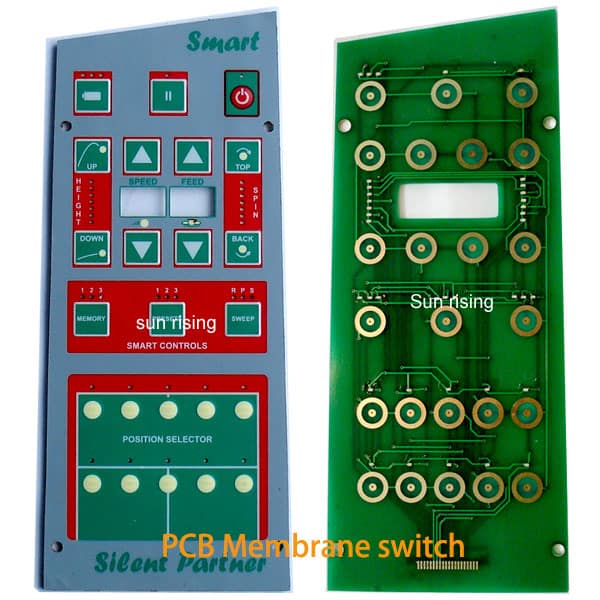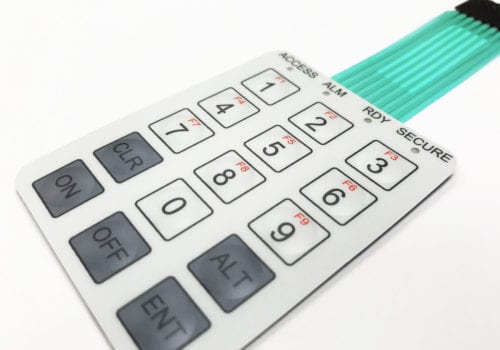Membrane Layer Change Technology: The Trick to Trustworthy and Economical Interfaces
Membrane switch innovation has actually arised as an essential component in the layout of user interfaces, providing both dependability and cost-effectiveness across a diverse variety of applications. As we explore the diverse benefits of membrane buttons, their potential for advancement increases concerns regarding future applications and progressing patterns.
Understanding Membrane Change Innovation
Membrane switch technology is a widely utilized interface remedy in various electronic devices, providing a seamless mix of performance and design. This modern technology incorporates multiple layers of products, normally containing a graphic overlay, spacer layer, and a circuit layer. The graphic overlay displays the interface aspects, while the spacer layer separates the circuit layer from the overlay until an individual triggers a button.
When stress is related to the overlay, the circuit layer completes the electric circuit, sending out a signal to the device. This device allows for numerous arrangements, including responsive comments and backlighting choices, enhancing customer communication. Membrane buttons are commonly made making use of resilient products such as polyester or polycarbonate, making sure durability and resistance to ecological aspects like dampness and dirt.
The adaptability of membrane layer changes enables their application in varied industries, consisting of clinical devices, consumer electronics, and industrial controls. Their compact style allows for assimilation into space-constrained atmospheres, offering an efficient customer interface without endangering visual charm. Comprehending the intricacies of membrane layer switch innovation is important for suppliers and designers seeking to create trusted and efficient human-machine user interfaces.
Secret Advantages of Membrane Buttons
While different user interface solutions exist, membrane switches offer distinctive benefits that make them a recommended option in various applications. One of the key advantages is their resilience; membrane layer buttons are made to endure harsh ecological conditions, consisting of dampness, dust, and temperature changes, making certain lasting efficiency. This resilience substantially decreases the requirement for frequent substitutes, consequently decreasing total upkeep prices.

Furthermore, membrane buttons are lightweight and small, making them suitable for applications where room is restricted. Their inconspicuous layout adds to a sleek appearance without compromising capability.
Cost-effectiveness is additionally a remarkable advantage, as the manufacturing procedure for membrane switches has a tendency to be less costly contrasted to typical mechanical switches. This cost, combined with their integrity and ease of installation, important source positions membrane layer more information changes as a practical option for a broad range of sectors looking for efficient and reliable interface.
Applications Throughout Numerous Industries
How do membrane buttons adapt to the diverse requirements of numerous industries? Membrane switch innovation is progressively acknowledged for its convenience, making it ideal for a vast variety of applications throughout several sectors.
In consumer electronic devices, membrane switches offer a portable remedy for remotes and home appliances, enhancing user experience with user-friendly layout. Additionally, the industrial industry leverages membrane layer buttons for equipment control panels, taking advantage of their resistance to extreme atmospheres, such as wetness and dust.
Armed forces and aerospace applications likewise use membrane switches for their reliability and capacity to hold up against severe problems, guaranteeing operational effectiveness in critical situations. The food and beverage industry adopts these buttons for automated systems, where cleanliness and simplicity of operation are paramount (membrane switch). Ultimately, membrane layer buttons are customized to satisfy the distinct demands of each industry, proving their important role in modern-day innovation user interfaces
Style and Personalization Options

In the realm of membrane button innovation, design and modification alternatives play an essential function in improving performance and customer interaction. These buttons can be customized to meet details functional requirements and visual preferences, making them flexible components in different applications.
One of the key customization alternatives is the layout of the button itself, which can be created to fit one-of-a-kind user interfaces and ergonomic considerations. By adjusting the shape, dimension, and arrangement of switches, suppliers can create instinctive styles that help with convenience of use. In addition, the incorporation of different shades and graphic overlays permits branding and improved visibility, making sure that individuals can swiftly recognize functions.
Furthermore, membrane buttons can be crafted with various responsive responses mechanisms, such as raised switches or distinct clicks, to enhance the customer experience. Various materials can likewise be chosen for resilience and ecological resistance, resolving aspects such as wetness, temperature level fluctuations, and chemical exposure.
Ultimately, site the substantial layout and customization options available in membrane switch innovation encourage businesses to create customized remedies that not just meet functional requirements however additionally straighten with their branding and functional demands.

Future Trends in Membrane Switches
As membrane layer button innovation proceeds to evolve, future trends are progressively concentrated on improving individual experience and incorporating innovative capabilities. One significant trend is the combination of touch-sensitive and capacitive innovations into traditional membrane buttons. This growth permits even more instinctive user interfaces, providing tactile feedback while maintaining a sleek design.
An additional emerging trend is the use of eco-friendly materials, driven by the growing need for lasting manufacturing practices. Producers are seeking to minimize their carbon footprint by using recyclable substrates and low-impact inks, straightening with international sustainability objectives.
In addition, the surge of the Web of Things (IoT) is triggering the consolidation of clever attributes into membrane layer buttons. Boosted connectivity choices will enable devices to connect with each other, enabling smooth combination into broader systems.
In addition, improvements in printing innovations, such as digital printing, are permitting higher design flexibility and customization. This makes it possible for manufacturers to produce intricate designs and vibrant colors cost-effectively.

Verdict
To conclude, membrane button technology stands for an important development in customer interface style, offering considerable benefits in toughness, modification, and cost-effectiveness. Its widespread applicability throughout diverse markets emphasizes its significance in modern-day innovation. As developments remain to emerge, specifically in touch-sensitive interfaces and lasting products, the potential for membrane layer switches to improve customer experience and performance continues to be promising. Continued expedition of this technology will likely yield even more renovations and broaden its scope in future applications.